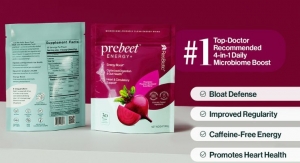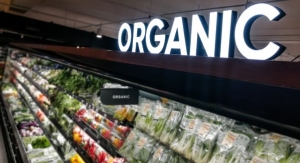01.10.23
The food system has been undergoing a high level of change and unpredictability due to inflation, supply chain disruption, technological advancement, changing consumer behaviors, and more.
Overall, wellness will continue to influence consumer behavior in 2023, according to the International Food Information Council (IFIC).
The organization said to expect products to offer new caffeine alternatives to coffee and tea. Along with yerba mate, yaupon tea offers a lower-caffeine option with a sweet flavor profile, which is derived from a species of holly native to the deep South.
Mocktails and nonalcoholic cocktail options continue to take up more real estate on menus and grocery store shelves, and are especially popular among younger consumers.
While energy was the most sought-after food benefit for all adult population groups, according to the 2022 Food and Health Survey, “emotional/mental health” was among the top three sought out by Gen Z, with more members of the generation desiring this benefit compared to their older counterparts.
Among those who made a change to their nutrition or diet in 2022 to manage or reduce their stress, 33% said they consumed foods/beverages that are supposed to reduce stress or the effects of stress, and 24% said they drank less alcohol.
Similar to consumers’ pursuit of energy benefits, beverages are also viewed as a delivery system for probiotics and prebiotics. According to IFIC’s 2022 Consumer Insights on Gut Health and Probiotics Survey, of those who try to consume probiotics, 25% said they commonly seek them out in wellness drinks. Similarly, among those who try to consume prebiotics, 23% seek them from wellness drinks.
Consumers are becoming more comfortable with innovative, plant-based food alternatives, a trend that IFIC expects to continue in 2023. An IFIC survey in December 2021 found that 28% would be interested in trying sea green-based products (e.g., algae- or kelp-based foods). Keep an eye out for food innovations featuring mushrooms, seaweed, and jackfruit, IFIC said.
“Natural” and “clean” foods, which consumers associate with healthfulness, will continue to be at the forefront. According to the 2022 Food and Health Survey, more Americans in 2022 vs. 2021 said they regularly buy products labeled as “natural” (39% vs. 33% in 2021) or “clean ingredients” (27% vs. 20% in 2021).
When asked about which types of diets or eating patterns they’re following, clean eating was the top choice. More respondents said they followed clean eating in 2022 (16%) than in 2021 (9%).
Recent actions by the Food and Drug Administration (FDA) are bringing Americans closer to an updated definition of “healthy” foods. As far as consumers are concerned, the most common attributes they believe define a healthy food are “fresh” (37%), “low in sugar” (32%) and “good source of protein” (29%), according to the 2022 Food and Health Survey.
When consumers were asked in a 2021 IFIC survey to rate their level of interest in trying certain products, 19% said they would be interested in cell-cultured meat. In 2023, Americans will become increasingly familiar with meat derived from animal cells. At the same time, industry will needs to find consensus on what to call those foods in the first place. According to one survey, “cultivated meat” is emerging as a front-runner.
This past fall, the White House Conference on Hunger, Nutrition, and Health brought stakeholders across multiple sectors together to address food insecurity and diet-related diseases. The ripples from the conference will be seen into 2023 and beyond.
The 2020-2025 Dietary Guidelines for Americans spotlighted the importance of diversity and cultural traditions in reaching more of the U.S. population. The United Nations agency UNESCO recently added to its list of “intangible cultural heritage,” new entries which are replete with foods and beverages that are steeped in tradition and ritual.
At the same time, food companies are also looking to values like diversity, equity and inclusion as ways to attract the best talent and grow thoughtfully.
To succeed in today’s global economy, companies will need to pay attention to local forces. Americans have become much more conversant about global supply chains and what happens when they are disrupted by factors like the pandemic and war. The COVID-19 pandemic prompted many to reconsider how the products we take for granted every day don’t just appear on the shelves magically.
The cascading effects of world events aren’t limited to supply and demand. They also put upward pressure on prices. For instance, 83% of U.S. consumers noticed an increase in the cost of food and beverages in the past year, according to the 2022 Food and Health Survey. Of those who observed an increase, 57% reported having to pay more for the same item as a result of increasing prices and 29% said they purchased less overall than they would have otherwise.
Overall, wellness will continue to influence consumer behavior in 2023, according to the International Food Information Council (IFIC).
Cheers to Health
Healthy drinks are in-demand, driven in part by consumers looking for added benefits like energy, mental health, and gut health support. IFIC’s 2022 Food and Health Survey found that “more energy and less fatigue” were the most sought-after benefit from foods and beverages (37% of Americans).The organization said to expect products to offer new caffeine alternatives to coffee and tea. Along with yerba mate, yaupon tea offers a lower-caffeine option with a sweet flavor profile, which is derived from a species of holly native to the deep South.
Mocktails and nonalcoholic cocktail options continue to take up more real estate on menus and grocery store shelves, and are especially popular among younger consumers.
While energy was the most sought-after food benefit for all adult population groups, according to the 2022 Food and Health Survey, “emotional/mental health” was among the top three sought out by Gen Z, with more members of the generation desiring this benefit compared to their older counterparts.
Among those who made a change to their nutrition or diet in 2022 to manage or reduce their stress, 33% said they consumed foods/beverages that are supposed to reduce stress or the effects of stress, and 24% said they drank less alcohol.
Gut Connections
Probiotics have continued to gain popularity, with digestive/gut health the third most commonly sought-after benefit among Americans, according to IFIC. Beyond the yogurt section, probiotics are increasingly being added to non-traditional foods like chocolate, ice cream, juices, sauces, and nutrition bars.Similar to consumers’ pursuit of energy benefits, beverages are also viewed as a delivery system for probiotics and prebiotics. According to IFIC’s 2022 Consumer Insights on Gut Health and Probiotics Survey, of those who try to consume probiotics, 25% said they commonly seek them out in wellness drinks. Similarly, among those who try to consume prebiotics, 23% seek them from wellness drinks.
Plant-Based Innovation?
Beyond plant-based meat and dairy, newer products are focusing on sustainability and innovation, often relying on “upcycling,” which takes plant-based food components that ordinarily would have gone to waste and processes them for use in other products—such as pulp and spent grain from soy milk or oat milk being added to flour. Upcycling reduces food waste and contributes to sustainable food production.Consumers are becoming more comfortable with innovative, plant-based food alternatives, a trend that IFIC expects to continue in 2023. An IFIC survey in December 2021 found that 28% would be interested in trying sea green-based products (e.g., algae- or kelp-based foods). Keep an eye out for food innovations featuring mushrooms, seaweed, and jackfruit, IFIC said.
Clarity and Confusion for Food Packages
Expect to see more jostling in 2023 for the finite space on food labels. In a similar vein, greater consensus will begin emerging around nomenclature, as well as some of the terms and marketing claims that will be vying for more of the labels’ real estate.“Natural” and “clean” foods, which consumers associate with healthfulness, will continue to be at the forefront. According to the 2022 Food and Health Survey, more Americans in 2022 vs. 2021 said they regularly buy products labeled as “natural” (39% vs. 33% in 2021) or “clean ingredients” (27% vs. 20% in 2021).
When asked about which types of diets or eating patterns they’re following, clean eating was the top choice. More respondents said they followed clean eating in 2022 (16%) than in 2021 (9%).
Recent actions by the Food and Drug Administration (FDA) are bringing Americans closer to an updated definition of “healthy” foods. As far as consumers are concerned, the most common attributes they believe define a healthy food are “fresh” (37%), “low in sugar” (32%) and “good source of protein” (29%), according to the 2022 Food and Health Survey.
When consumers were asked in a 2021 IFIC survey to rate their level of interest in trying certain products, 19% said they would be interested in cell-cultured meat. In 2023, Americans will become increasingly familiar with meat derived from animal cells. At the same time, industry will needs to find consensus on what to call those foods in the first place. According to one survey, “cultivated meat” is emerging as a front-runner.
Diversity, Equity, and Inclusion (DEI)
According to the 2022 Food and Health Survey, 45% of U.S. consumers said that fair and equitable treatment of workers in the food system is important in their purchasing decisions.This past fall, the White House Conference on Hunger, Nutrition, and Health brought stakeholders across multiple sectors together to address food insecurity and diet-related diseases. The ripples from the conference will be seen into 2023 and beyond.
The 2020-2025 Dietary Guidelines for Americans spotlighted the importance of diversity and cultural traditions in reaching more of the U.S. population. The United Nations agency UNESCO recently added to its list of “intangible cultural heritage,” new entries which are replete with foods and beverages that are steeped in tradition and ritual.
At the same time, food companies are also looking to values like diversity, equity and inclusion as ways to attract the best talent and grow thoughtfully.
Global vs. Local
IFIC also noted the interplay between globalization that respects and adapts to unique local needs and conditions (“glocalization”).To succeed in today’s global economy, companies will need to pay attention to local forces. Americans have become much more conversant about global supply chains and what happens when they are disrupted by factors like the pandemic and war. The COVID-19 pandemic prompted many to reconsider how the products we take for granted every day don’t just appear on the shelves magically.
The cascading effects of world events aren’t limited to supply and demand. They also put upward pressure on prices. For instance, 83% of U.S. consumers noticed an increase in the cost of food and beverages in the past year, according to the 2022 Food and Health Survey. Of those who observed an increase, 57% reported having to pay more for the same item as a result of increasing prices and 29% said they purchased less overall than they would have otherwise.


























